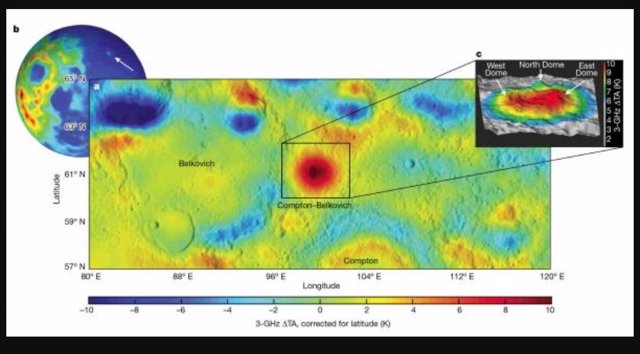July 7 () –
A new type of instrument aboard Chinese orbiters has discovered evidence of a volcanic process on the Moon that had only been seen on Earth.
“Before the 1950s, most scientists thought that craters on the Moon were from volcanoes, then, studies associated with the Apollo missions showed that almost all were from impactssaid Matthew Siegler, senior scientist at the Planetary Sciences Institute (PSI) and author of the new research appearing in Nature.
“There was abundant volcanism, with flood basalts, thin flowing lavas, covering about 16% of the Moon, but not much in the way of thicker silicic lavas that could form something we would call a volcano,” Siegler said it’s a statement.
“Using an instrument that analyzes the longer-than-infrared microwave wavelengths sent to the Moon on China’s Chang’E 1 and 2 orbiters, we have been able to map the temperatures below the surface. What we found was that one of these suspected volcanoes, known as Compton-Belkovich, absolutely glowed at microwave wavelengths,” Siegler said.
“What this means is that it’s hot, not necessarily on the surface, as you’d see in infrared, but below the surface. The only way to explain this is by extra heat coming from somewhere below the feature within. of the deepest lunar crust. So Compton-Belkovich, which is thought to be a volcano, also hides a huge heat source underneath it.”
Evidence from the surface shows that this volcano probably last erupted 3.5 billion years ago, so the heat isn’t coming from molten lava or anything, it’s coming from the radioactive elements in the rock now solid. The only type of rock that actually contains enough radioactive elements is granite. So data collected with a fundamentally new type of microwave instrument shows that a large volcano on the Moon was once fed by a much larger granite magma chamber below it: the most Earth-like volcanism on the Moon.
A granitic batholith is a huge 20+ kilometer body of what was once subterranean lava that never erupted. Batholiths lie beneath volcanic chains, such as the Andes or Cascadia mountain ranges, and are basically the plumbing system that feeds them. When these plumbing systems cool, they form granite. Granites, almost absent in the Solar System outside of Earth, they are a type of rock that is basically cooled lava that never made it to the surface.
“It was a cool project where China made their data public, as did NASA, and we were able to work with this unique data set to find out something really interesting about the Moon. By following the rules, we couldn’t collaborate directly with Chinese researchers. and all the funds came only from NASAso we had to follow the breadcrumbs to open this dataset”, Siegler said.






![[Img #74662]](https://thelatestnews.world/wp-content/uploads/2024/12/Organisms-with-the-shortest-life-150x150.jpg)





![[Img #74662]](https://thelatestnews.world/wp-content/uploads/2024/12/Organisms-with-the-shortest-life-300x200.jpg)
